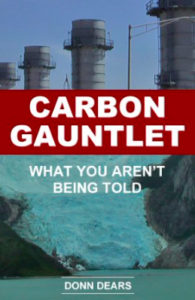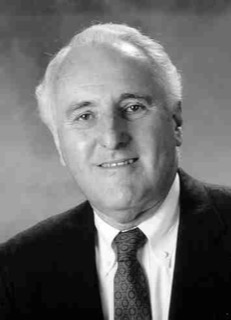
by Donn Dears
Any attempt to cut CO2 emissions must run a gauntlet of hurdles – some of which may be insurmountable. These hurdles are largely hidden from public view.
Carbon Gauntlet describes these hurdles and provides Americans with the information they need to judge whether the government should force Americans, including industries and utilities, to cut CO2 emissions.
The United Nations has said the United States and other developed countries must cut their CO2 emissions 80% by 2050 or there will be a climate catastrophe. The EPA has adopted the UN’s 80% target.
President Obama has said, “My Presidency will mark a new chapter in America’s leadership on climate change.”
He recently said he wouldn’t wait for Congress and would have the EPA and other Federal agencies act to cut CO2 emissions.
Is it possible to cut CO2 emissions enough to prevent climate change?
That’s the question Carbon Gauntlet analyzes. It doesn’t try to argue whether or not CO2 causes climate change.
Carbon Gauntlet begins by describing the source, by sector, of CO2 emissions in the United States.
It then analyzes each of the technologies needed to cut CO2 emissions 80% by 2050.
It examines each sector, gasoline, power generation, industrial, transportation (other than gasoline), residential and commercial as to what it would mean to cut CO2 emissions 80% by 2050.
It explains how the United Nations Framework Convention on Climate Change (UNFCCC) was established at the Earth Summit in Rio de Janeiro, and the ramifications of its having been ratified by the U.S. Senate.
The UNFCCC is virtually unknown to most Americans, yet it holds annual meetings, which the United States must attend.
Carbon Gauntlet describes why Europe has adopted policies to cut CO2 emissions and why Europe has inherently lower per capita CO2 emissions than the United States.
Carbon Gauntlet provides information on conservation and possible breakthrough technologies, including the recent use of fracking.
The media avoids telling people about the difficulties of cutting CO2 emissions, so many people assume it’s easy to cut and sequester CO2 emissions. The media doesn’t explain the ramifications of cutting CO2 emissions, while Carbon Gauntlet does.
What will it mean to cut per capita CO2 emissions to the same level they were in 1900? Yet, this is what must happen if CO2 emissions are to be cut 80% by 2050.
Carbon Gauntlet is a relatively short book, packed with important information that explains the issues facing the United States if it attempts to cut CO2 emissions 80% by 2050.
Carbon Gauntlet is a must read for everyone as the United States begins to implement policies to cut CO2 emissions 80% by 2050.
About the Author
Donn spent his career at General Electric Company in the power sector, leading organizations that provided engineering services for GE’s large electrical apparatus. Donn led the establishment of GE subsidiary companies around the world and actively participated in providing engineering services to a wide range of industries including electric utilities, steel, mining and transportation.
He retired as a senior GE Company executive and served on active duty in the Navy during the Korean War.
Donn Dears
